Highlights
To our fellow Educators,
A big thank you for joining us at our “Let’s get inclusive!” Naptime Webinar with Ms. Shelby Hiadan (NIEC-NP)!
We hope that through this webinar, you have gained a greater understanding of Inclusive Practice and learnt new ways to create a more inclusive classroom so that all children can play, learn and contribute meaningfully.
In case you've missed it...
Here are key highlights from our webinar!
|
|
Relive the moment - watch Shelby's presentation!
|
|
Catch a snippet of the Q&A segment that day! Hear what Mrs. Loke (Director, NIEC), Ms. Claire Chan (Lecturer, NIEC-TP) and Shelby have to say about Inclusive Practices. |
If not, you can always read up on Shelby's tips for a more inclusive classroom!
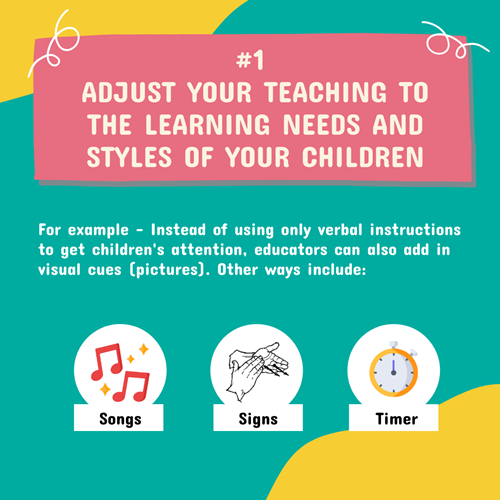 |
 |
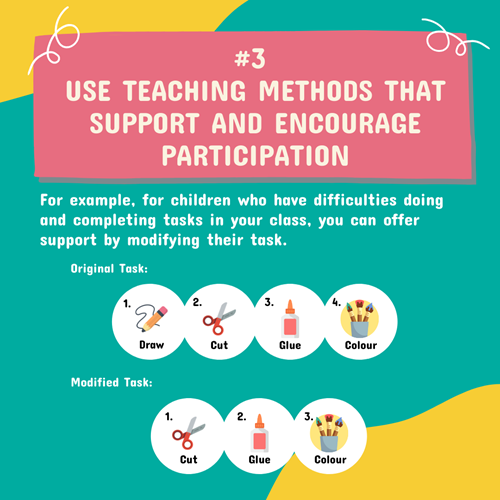 |

You've asked, we've answered
During the Q&A, we've received so many questions from the audience and they were so good we had to share them here!
|
Q. Even after including visual, kinesthetic and auditory cues, what can educators do if a child has trouble focusing or staying still?
It is not just about how you can adjust the current activities in the classroom to make them more interesting and engaging, but also understanding the profile of the children and their interests so as to be able to select and provide the right materials for them. It is also important to note that managing a class is not just about managing the children's behaviour but the classroom environment as well.
|
|
Q. The movement breaks take 10 - 15 minutes at least. How else can educators use the movement breaks, or other methods, to get and retain children's attention?
Movement breaks should ideally be 5 minutes or less. One way to ensure that it does not take too long is to have a child perform 1 - 2 actions and let the rest of the children copy. Chunking of an activity can also help. This is when you divide a 15-minute activity into "chunks", checking in once in a while with the children to ensure they are doing ok and are able to follow and understand instructions.
|
|
Q. How do we identify if a child has developmental needs?
We leave the "proper" identification of children with developmental needs to the developmental pediatricians and psychologists. As teachers, one of our roles is to observe if there are children who are having difficulties in certain learning areas. From there, we help the child with his/her difficulty using various activities and strategies. Challenges and difficulties among children do persist; and if it does, we can take the next step and speak with the centre leader/principal about it. Thereafter, the parents can be included in the discussion, to see if there is a need to refer the child to a specialist for assessment or to try other activities and strategies.
xxxxxxxxxxxxxxxxxxxxxxxxxxxxxxxxxxxxxxxxxxxxxxxxxxxxxxxxxxxxxxxxxxxxxxxxxxxxxxxxx
If you would like to enhance your knowledge on inclusive strategies to better support children with developmental needs in your classroom, check out the Specialist Diploma in Early Childhood Learning Support (SDELS) and Specialist Diploma in Early Childhood Intervention (Special Needs) (SDESN) courses offered at NIEC.
|
|
Q. A child with developmental needs is being ostracised by their peers. What can I do to encourage friendships and social connections among the children?
We would like to assure educators that this happens often, even with typically developing children. As teachers, we can foster and encourage social interactions in the classroom by scaffolding and guiding children to interact with one another. Sometimes, a simple move like placing books on friendships at the reading corner helps! It is also encouraged for educators to communicate often with the children and motivate them to be nice to one another. All these efforts could aid in promoting the awareness of self and others and can foster empathy towards others.
|
|
Q. "A high teacher-child ratio makes it difficult for educators to be inclusive."
This is a myth that should be busted! It is still possible to provide the necessary support and learning for the children despite having high teacher-child ratio in the classroom. The materials we make should be appropriate and easily adaptable for all children in our classrooms. It is also important to work together with other teachers by sharing resources and materials. This way, you can be assured to have enough materials to go around.
|
|
Q. What can educators do if they do not receive sufficient resources or support from centres to cater to children with developmental needs?
You do not need to have complicated or fanciful learning materials. All you need are ideas and a couple of items that can be readily found around the classroom! For example, making tracing letters with salt and sand to help the child learn about letter formations. Alternatively, you can even use the same materials for the whole class, with some adjustments for the child with developmental needs.
|
|
Q. What if parents do not want to engage with us on their child who needs additional support?
Finding out more from the parent on how he/she supports the child at home, sharing positive moments that took place in class or providing them with classroom strategies which are easily adaptable for use at home can help to develop a stronger relationship between teacher and parent. This makes it easier to encourage parents to be more inclusive towards the support of their child. Most importantly, we should also assure parents with words of encouragement because it is not easy looking after a child with developmental needs 24/7 and a little dose of positivity goes a long way.
|
|
Q. Are there any resources for educators to introduce inclusion to children?
Yes, there are! In partnership with the National Library Board (NLB), we have collated a list of children books that introduce inclusion and talk about the value of embracing individuality, kindness and diversity. In this list, you will find useful learning resources to enhance your knowledge on inclusive strategies to better support children with developmental needs in your classroom as well. Click here to download it now!
|

Wanna know more about Inclusive Practice?
Read this article written by our faculty!
Thinking and being inclusive is a journey
|
|
If those don’t work, here are some other key strategies to manage behaviour in the classroom! (applicable for use for all students):
|
|
Now that you have these strategies, coupled with your sound knowledge of children’s abilities and established relationships with your fellow educators, you are ready to take on any challenges that may occur in your classroom!
|

For more resources
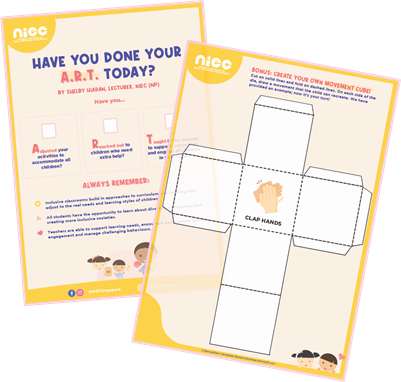 |
Click here to download a copy of the digital handout for a checklist you can place in your classroom to act as a daily reminder and a template of the movement cube to use with your children. |
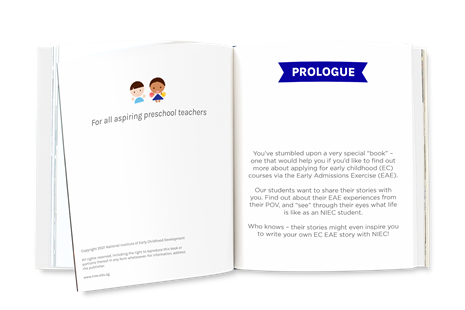 |
Click here for useful learning resources which you can use to enhance your knowledge on inclusive strategies to better support children with developmental needs. |
Stay connected with the NIEC fraternity
Click on the 'Join Mailing List' button on the right and be the first to know about our upcoming workshops, webinars and more!
Join us on social media too!
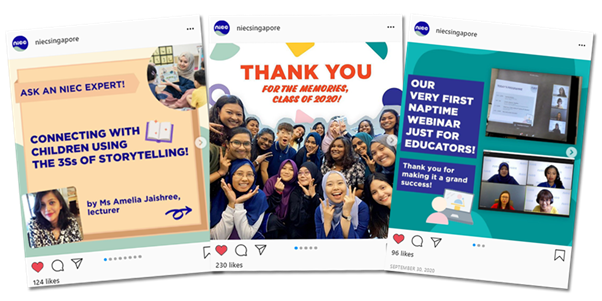
Stay up-to-date with expert tips from our faculty, event highlights, and other fun content for EC educators.
Follow us @NIECSingapore!


